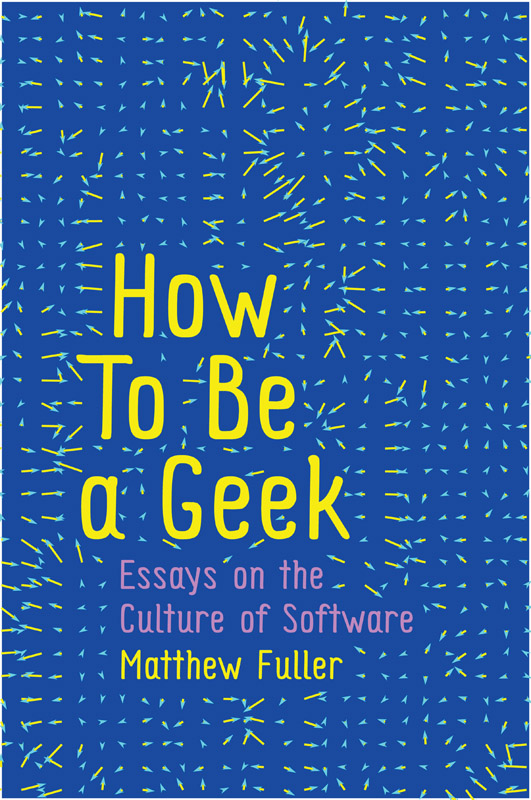Matthew Fuller: How To Be a Geek: Essays on the Culture of Software (2017)
Filed under book | Tags: · aesthetics, algorithm, computation, computing, database, information, language, media, media theory, networks, programming, software, software studies, theory

“Computer software and its structures, devices and processes are woven into our everyday life. Their significance is not just technical: the algorithms, programming languages, abstractions and metadata that millions of people rely on every day have far-reaching implications for the way we understand the underlying dynamics of contemporary societies.
In this innovative new book, software studies theorist Matthew Fuller examines how the introduction and expansion of computational systems into areas ranging from urban planning and state surveillance to games and voting systems are transforming our understanding of politics, culture and aesthetics in the twenty-first century. Combining historical insight and a deep understanding of the technology powering modern software systems with a powerful critical perspective, this book opens up new ways of understanding the fundamental infrastructures of contemporary life, economies, entertainment and warfare.
In so doing Fuller shows that everyone must learn ‘how to be a geek’, as the seemingly opaque processes and structures of modern computer and software technology have a significance that no-one can afford to ignore. This powerful and engaging book will be of interest to everyone interested in a critical understanding of the political and cultural ramifications of digital media and computing in the modern world.”
Publisher Polity, 2017
ISBN 9781509517152, 1509517154
x+233 pages
Forensic Architecture (ed.): Forensis: The Architecture of Public Truth (2014)
Filed under book | Tags: · aesthetics, architecture, art, forensics, image, law, politics, theory, war

“Forensics originated from the term ‘forensis’ which is Latin for ‘pertaining to the forum.’ The Roman forum was a multidimensional space of negotiation and truth-finding in which humans as well as objects participated in politics, law, and the economy. With the advent of modernity, forensics shifted to refer exclusively to the courts of law and to the use of medicine, and today as a science in service to the law. The present use of forensics, along with its popular representations have become increasingly central to the modes by which states police and govern their subjects.
By returning to forensis this book seeks to unlock forensics’ original potential as a political practice and reorient it. Inverting the direction of the forensic gaze it designates a field of action in which individuals and organizations detect and confront state violations.
The condition of forensis is one in which new technologies for mediating the “testimony” of material objects—bones, ruins, toxic substances, landscapes, and the contemporary medias in which they are captured and represented—are mobilized in order to engage with struggles for justice, systemic violence, and environmental transformations across the frontiers of contemporary conflict.
This book presents the work of the architects, artists, filmmakers, lawyers, and theorists who participated directly in the “Forensic Architecture” project in the Centre for Research Architecture at Goldsmiths University of London, as well as the work of associates and guests. It includes forensic investigations undertaken by the project and its collaborators aimed at producing new kinds of evidence for use by international prosecutorial teams, political organizations, NGOs, and the UN. It also brings together research and essays that situate contemporary forensic practices within broader political, historical, and aesthetic discourse.”
With contributions by Lawrence Abu Hamdan, Nabil Ahmed, Maayan Amir, Hisham Ashkar & Emily Dische-Becker, Ryan Bishop, Jacob Burns, Howard Caygill, Gabriel Cuéllar, Eitan Diamond, DAAR (Decolonizing Architecture Art Residency), Anselm Franke, Grupa Spomenik, Ayesha Hameed, Charles Heller, Helene Kazan, Thomas Keenan, Steffen Krämer, Adrian Lahoud, Armin Linke, Jonathan Littell, Modelling Kivalina, Model Court, Working Group Four Faces of Omarska, Gerald Nestler, Godofredo Pereira, Nicola Perugini, Alessandro Petti, Lorenzo Pezzani, Cesare P. Romano, Susan Schuppli, Francesco Sebregondi, Michael Sfard, Shela Sheikh, SITU Research, Caroline Sturdy Colls, John Palmesino & Ann Sofi Ronnskog / Territorial Agency, Paulo Tavares, Füsun Türetken, Robert Jan van Pelt, Srdjan Jovanovic Weiss / NAO, Eyal Weizman, Ines Weizman, Chris Woods.
Publisher Sternberg Press, Berlin, and Forensic Architecture, London, 2014
ISBN 9783956790119, 3956790111
744 pages
Reviews: Léopold Lambert (The New Inquiry, 2014), Martin Howse (Mute, 2014), Gaston Gordillo (Society and Space, 2015), John Beck (Radical Philosophy, 2015).
Exh. review: Harry Burke and Lucy Chinen (Rhizome, 2014).
Exhibition
Publisher
Publisher
WorldCat
PDF (22 MB, updated on 2021-1-6)
Comment (0)Christoph Cox, Jenny Jaskey, Suhail Malik (eds.): Realism Materialism Art (2015)
Filed under book | Tags: · aesthetics, art theory, materialism, matter, object, object-oriented ontology, philosophy, realism, representation, speculative realism, technology, theory

“Realism Materialism Art (RMA) introduces a diverse selection of new realist and materialist philosophies and examines their ramifications on the arts. Encompassing neo-materialist theories, object-oriented ontologies, and neo-rationalist philosophies, RMA serves as a primer on ‘speculative realism,’ considering its conceptual innovations as spurs to artistic thinking and practice and beyond. Despite their differences, these philosophical positions propose that thought can and does think outside itself, and that reality can be known without its being shaped by and for human comprehension. Today’s realisms and materialisms explicitly challenge many of the dominant assumptions of cultural practice and theoretical inquiry, opening up new domains of research and artistic inquiry.”
Contributions by Armen Avanessian, Elie Ayache, Amanda Beech, Ray Brassier, Mikko Canini, Diana Coole, Christoph Cox, Manuel DeLanda, Diedrich Diederichsen, Tristan Garcia, Iain Hamilton Grant, Elizabeth Grosz, Boris Groys, Graham Harman, Terry Horgan, Jenny Jaskey, Katerina Kolozova, James Ladyman, François Laruelle, Nathan Lee, Suhail Malik, Quentin Meillassoux, Reza Negarestani, John Ó Maoilearca, Trevor Paglen, Luciana Parisi, Matthew Poole, Matjaž Potrč, João Ribas, Matthew Ritchie, Alicia Ritson, Susan Schuppli, Steven Shaviro, Nick Srnicek, Achim Szepanski, Eugene Thacker, McKenzie Wark, Andy Weir.
Publisher Center for Curatorial Studies, Bard College, NY, and Sternberg Press, Berlin, 2015
ISBN 9783956791260, 3956791266
403 pages
Reviews: Ilse van Rijn (Open, 2015), Hatty Nestor (Review31, n.d.).
PDF (14 MB)
Comment (0)
